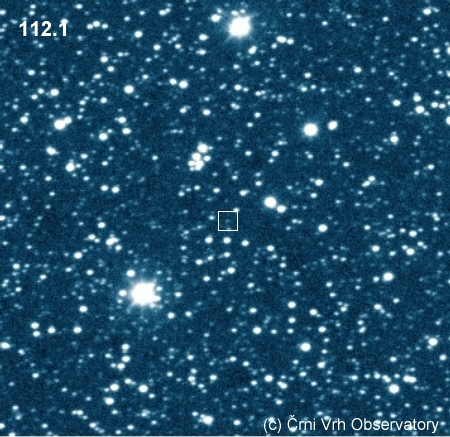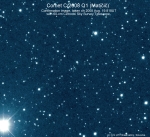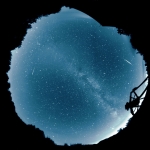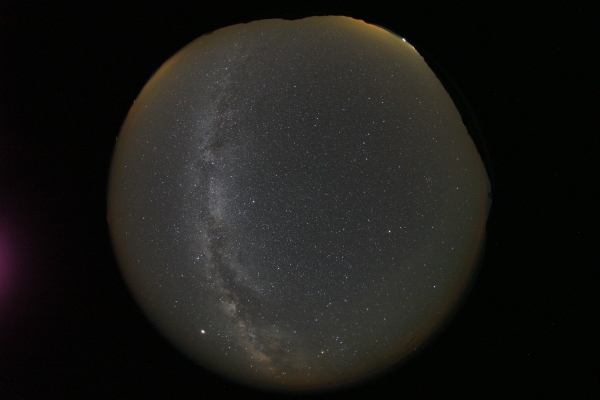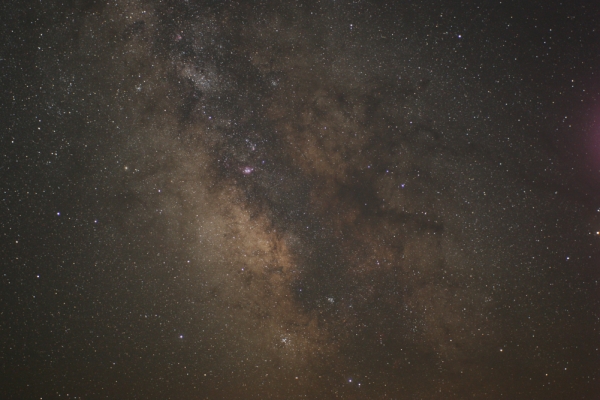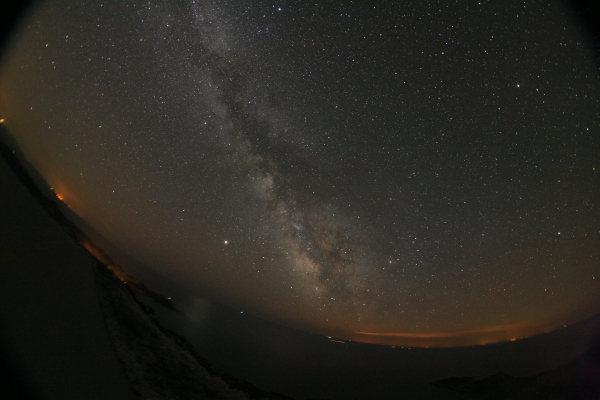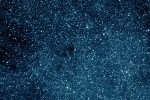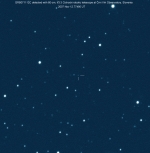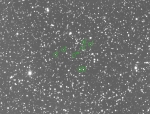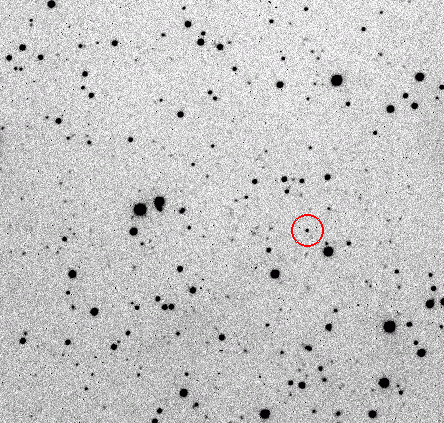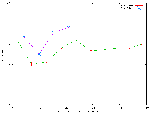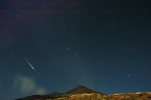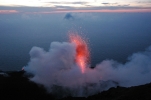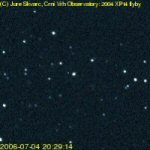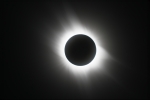| News 2006 - 2008 |
| Detection of optical counterpart of GRB081126 at Črni Vrh Observatory (Nov. 26, 2008) | ||||
| We observed optical counterpart of Gamma Ray Burst GRB081126 (Swift trigger 335647) using 60 cm Cichocki robotic telescope at Črni Vrh Observatory. A new object was detected at RA=21:34:03.56, DEC=+48:42:38.62 (J2000). Series of twenty connsecutive Rc filter exposures were taken, starting at 21:35:32UT, 67 seconds after the GCN notice time. We confirm the presence of variable source, identified by Sergeev and Pozanenko (GCN Circ. 8558). The object was clearly detected on all 20 frames. Complete results are published in GCN 8569 Circular. |
|
Relevant links:
|
| Discovery of Supernova 2008gk at Črni Vrh Observatory (Oct. 20, 2008) | ||||
| On images taken by Stanislav Matičič in the course of the Črni Vrh Asteroid and Comet Search program PIKA, an apparent supernova (mag 18.2) was detected using software for automatic discovery of static objects. Supernova was found on four consecutive unfiltered CCD images taken around 2008 Oct. 20.74 UT with a 0.60-m f/3.3 Cichocki Sky Survey Robotic Telescope. |
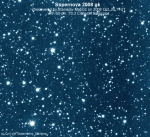
|
Discovery Image of Supernova 2008gk Composite image of supernova 2008gk was made by stacking four 40 second unfiltered discovery frames taken around 2008 Oct. 20.74UT with 60-cm, f/3.3 Deltagraph telescope. Image scale is about 1.4 arc sec/pixel. Copyright © 2008 by S. Matičič and H. Mikuž, Črni Vrh Observatory. |
|
The new object is located at R.A. = 18h53m04s.48, Decl. = +38o45'44".4 (equinox 2000.0; uncertainty about 0".2),
which is approximately 7" west and 6" north of the center of a nearby uncatalogued galaxy
Four PIKA R-band archival images obtained around Sept. 9.80 under moonlit conditions clearly show this
object at magnitude R = 17.7 +/- 0.1. Nothing is visible at this position on unfiltered archival PIKA
images obtained on 2005 July 4 (limiting magnitude 18.5) or on several Digitized Sky Survey red and blue
images from the Palomar Sky Survey.
Discovery was announced in CBAT Electronic Telegram No. 1544. Spectroscopic observations (CBET No. 1548), obtained on Oct. 22 UT with the 3-m Shane reflector (+ Kast) at Lick Observatory, shows it to be a type-Ib/c supernova. Relevant links:
|
| NEO Asteroid 2008 TC3 few hours before the impact (October 7, 2008) | ||||
| A tiny asteroid (about 3 meter wide) 2008 TC3 was discovered on 2008 Oct. 6.27767UT by astronomers at Mt. Lemmon in Arizona, a day before it entered the atmosphere in Northern Sudan and exploded. Asteroids the size of 2008 TC3 hit Earth several times a year, but this is the first time one has been discovered before it hit. |
|
NEO Asteroid 2008 TC3 few hours before it hit the Earth The video shows animated motion between the stars, just few hours before the impact at 2h46 UT on October 7, 2008. This false color animation was composed from series of 20 second unfiltered exposures, obtained remotely during the NEO approach on 2008 Oct. 6 (19h15-21h43UT) with 60-cm, f/3.3 Cichocki telescope, and CCD. The telescope was programmed to precisely follow asteroid motion. Image scale is 2.79 arc sec/pixel. Movie composed and Copyrighted to © 2008 J. Skvarč, Črni Vrh Observatory.
High resolution AVI movie (56Mb) |
||||
|
Relevant links:
|
| Discovery of a NEO Asteroid 2008 TR2 at Črni Vrh Observatory (Oct. 5, 2008) | ||||
| On the night of 4-5 October 2008 a new NEO asteroid was discovered on images taken by Herman Mikuž in the scope of Comet and Asteroid Search Program PIKA at Črni Vrh Observatory. After the measurements were published on NEOCP the object was confirmed by several observatories worldwide. The orbital elements reveal that this object belongs to the Amor family of asteroids. Closest approach to Earth will be on 2008 Oct. 20 at 0.307AU. The object is designated as 2008 TR2 by the Minor Planet Center. The orbital period is 2.35 years. |
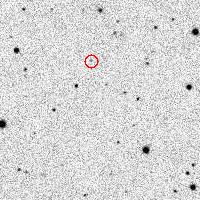
|
NEO Asteroid 2008 TR2 The animation shows discovery images of this object. Copyright © 2008 by H. Mikuž, Črni Vrh Observatory, Slovenia. |
|
Relevant links:
|
| Fireball from Delta Aurigid Meteor Shower (September 30, 2008) | ||||
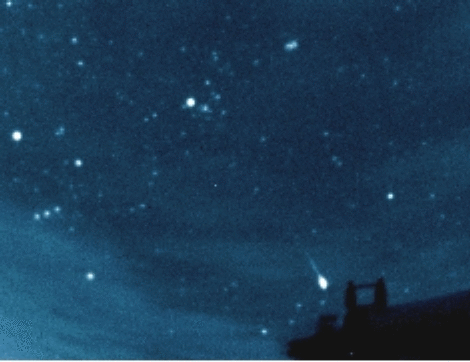
|
Delta Aurigid Fireball Delta-Aurigids are weak meteor shower, active between September 18 — October 10, with ZHR about 3. The maximum is not well defined and is presumed to occur between 2008 September 23 - October 3. September 28 is about the middle of this peak interval. This Delta Aurigid fireball animation is composed from 6 consecutive 1 minute exposures, obtained on 2008 Sep. 30, between 2h26m17s and 2h32m37sUT with remote all-sky camera. The fireball left a train of ionized gas that persisted for more than 6 minutes. It quickly changed the shape as it was blown by winds some 100 kilometers above the ground. Copyright © 2008 by Crni Vrh Observatory.
|
| Discovery of Supernova 2008fi at Črni Vrh Observatory (Sept. 4, 2008) | ||||
| On images taken by Jure Zakrajšek in the course of the Črni Vrh Asteroid and Comet Search program PIKA, an apparent supernova (mag 16.7) was detected using software for automatic discovery of static objects. Supernova was found on four consecutive unfiltered CCD images taken around 2008 Aug. 26.99 UT with a 0.60-m f/3.3 Cichocki Sky Survey Robotic Telescope. |
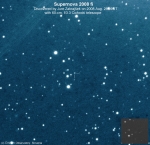
|
Discovery Image of Supernova 2008fi Composite image of supernova 2008fi was made by stacking four 40 second unfiltered discovery frames taken around 2008 Aug. 26.99UT with 60-cm, f/3.3 Deltagraph telescope. The inserted DSS image shows the area around the supernova host galaxy (barely visible on discovery image) to approximately the same scale. Image scale is about 0.9 arc sec/pixel. Copyright © 2008 by J. Zakrajšek and H. Mikuz, Črni Vrh Observatory. |
|
The new object is located at R.A. = 1h53m23s.17, Decl. = +29o21'28".4 (equinox 2000.0),
which is approximately 2" east and 2" south of the center of a nearby faint galaxy.
Nothing is visible at this location on several Palomar Sky Survey
images from the Aladin database. Nothing is visible at this location even on archival PIKA images, obtained
on 2003 Sept. 26, 2007 July 19 and 2008 Aug. 2 (limiting magnitude 18.5-19.0).
Additional photometry of 2008fi obtained with the 60-cm Cichocki reflector: 2008 Aug. 29.01, R = 17.47 +/- 0.02, V = 17.53 +/- 0.03; Sept. 2.91, R = 17.55 +/- 0.1; V = 17.80 +/- 0.1. Discovery was announced in CBAT Electronic Telegram No. 1493. Spectroscopic observations (CBET No. 1499), obtained on Sep. 4.0 UT with F. L. Whipple Observatory 1.5-m telescope (+ FAST), shows it to be a type-IIb supernova at about maximum light. Relevant links:
|
| 2008 QT3 First discovery of a Potentially Hazardous Asteroid at Črni Vrh Observatory (Aug. 24, 2008) | ||||
| On the night of 24 August 2008 an object with unusual motion was automatically detected on the images taken by Jure Skvarč in the scope of Comet and Asteroid Search Program at Črni Vrh Observatory. After the measurements were published on NEOCP the object was confirmed by several observatories worldwide. The orbital elements reveal that this object belongs to the Apollo family of asteroids. It will cross the Earth orbit mid-January 2009. Since it can approach Earth orbit closer than 0.05 AU and is big enough to cause substantial damage (500 - 1000 meter diameter), it is classified as a PHA - Potentially Hazardous Asteroid. At this moment the orbit is not well enough determined to estimate the risk of impact but probability is probably close to 0. Currently there are 976 PHAs. The object is designated as 2008 QT3 by the Minor Planet Center. Orbital elements after one day of observations show that it orbits the Sun in an elliptical orbit at a distance between 0.97 and 1.97 AU and an inclination of 7 degrees. The orbital period is 2.8 years. |
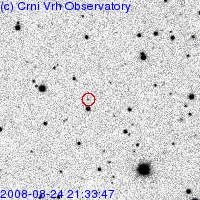
|
PHA 2008 QT3 The animation shows discovery images of this object. Copyright © 2006 by J. Skvarč, Črni Vrh Observatory, Slovenia. |
|
Relevant links:
|
| Discovery of comet C/2008 Q1 (Matičič) at Črni Vrh Observatory (Aug. 20, 2008) | ||||
|
On images taken by S. Matičič in the course of the Črni Vrh Asteroid and Comet Search
program PIKA,
on August 18, 2008 an object with unusual motion was automatically detected.
A new comet (first comet discovery from Črni Vrh Observatory) was detected on images taken between 2008 Aug. 18.81364UT and 18.84247UT with a
0.60-m f/3.3 Cichocki Sky Survey Telescope.
Further inspection of series of 1 minute unfiltered followup exposures obtained with the same telescope around 2008 Aug. 19.816UT show that this object has diffuse appearance (coma dia. ~10 arc sec) with strong condensation. After being posted on NEO Confirmation Page, additional measurements were obtained by several observatories. The discovery was announced in IAU Circular 8966. Complete observations and preliminary parabolic orbit were published in MPEC 2008-Q12. |
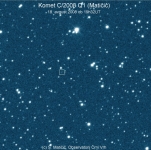
|
Comet C/2008 Q1 (Matičič) Comet C/2008 Q1 (Matičič) discovery image, obtained on 2008 Aug. 18 at 19h32UT with 0.60-m f/3.3 Cichocki Sky Survey Telescope at Črni Vrh Observatory. Image scale is 1.86 arc sec/pixel. Copyright © 2008 by S. Matičič, Črni Vrh Observatory. |
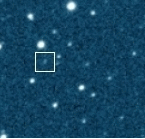
|
Comet C/2008 Q1 (Matičič) Animation image was made by stacking four 40 second discovery frames, taken between 2008 Aug. 18.814UT and 18.842UT with a 0.60-m f/3.3 Cichocki Sky Survey Telescope at Črni Vrh Observatory. Image scale is 1.86 arc sec/pixel. At the time of discovery, the comet was of magnitude 17.8 and moved at 1.4 arc sec/min in PA 255 degree. Copyright © 2008 by S. Matičič, Črni Vrh Observatory. |
|
Relevant links:
|
| 2008 Perseids from Črni Vrh Observatory (Aug. 14, 2008) | ||||
| High activity of Perseids meteor stream was recorded during the nights of 2008 Aug. 11-12 and 12-13. Several fireballs and meteors were recorded with newly set up Deep All Sky Camera, comprising Peleng 3.5/8 mm fisheye lens and FLI 1024 x 1024 back illuminated CCD camera. The camera lens was stopped to f/5.6 to give sharper images on standard 90 second exposures. Occasional cloud passages slightly affected observations. All images have dark and bias subtracted. |
| Alpha Capricornid Fireball (August 3, 2008) | ||||
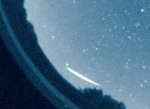
|
Alpha Capricornid Fireball The Alpha Capricornid meteor shower is active from mid-July to mid-September. Maximum seems to have several activity peaks (July 22, July 28 and August 5) with ZHR ranging from 6-14 meteors. The shower has the reputation of producing some of the brightest meteors of the major showers, with the average magnitude being estimated as about 2.2. More on Meteor Showers Online. This false color fireball image was obtained on 2008 Aug. 3 at 23h50m01sUT (center of exposure) with robotic all-sky camera. Exposure time was 1 minute. Copyright © 2008 by Crni Vrh Observatory.
|
| Expedition of Dark Sky Slovenia to Lastovo Island (May 10, 2008) | ||||
| During the April. 30. - May 4, 2008, a group of Dark Sky Slovenia members visited Lastovo Island in southern Adriatic. The aim of visit was to check the quality of night sky and verify it by obtaining images and instrumental measurements. Since the island is far away from large urban areas and with population of only around 800, we expected exceptionally dark night sky. In September 2006, Lastovo and surrounding islands were designated the Lastovo Archipelago Nature Park by Croatian Parliament. |
|
Although our night sky monitoring on Lastovo was limited to only three nights, there is strong evidence that
the sky is very dark, no doubt one of the darkest in Europe. Some light pollution is arriving from urban
areas in Dalmatian and Italian coast as well as from towns/villages on Lastovo and Korcula. Because of
growing tourism, state and local authorities should consider to protect this nice location from LP in future.
Action should be taken on two levels: if Croatia will adopt similar law as Slovenia (zero emission over the 90o),
the LP will be efficiently controlled. A less effective possibility would be to adopt the law in local Lastovo
commune. This would at least reduce emission from local unshielded light sources. Most of outside lighting in
Lastovo, Ubli, Skrivena Luka and Pasadur is very old and need to be replaced in near future. Now it is nice
opportunity to choose and set up fully shielded lamps and help to preserve this excellent location to future
generations. Lastovo has a good potential to became a European center of astro tourism which is not limited
only to summer but would be of interest all over the year.
Relevant links:
|
| Nova Sagittarii 2008 (April 20, 2008) | ||||
| Total Moon Eclipse (February 21, 2008) | ||||
| NEO Asteroid 2007 TU24 Flyby (January 29, 2008) | ||||
| On January 29, 2008, NEO asteroid 2007 TU24 passed the Earth at a distance of 0.0046 a. u. (690.000 kilometers), which is less than twice the Earth-Moon distance. |
|
NEO Asteroid 2007 TU24 Flyby Movie This false color animation was composed from series of 5 second exposures, obtained remotely during the NEO closest approach on 2008 Jan. 29/30 (22h10-4h00UT) with 60-cm, f/3.3 Cichocki telescope, R filter and CCD. The telescope was programmed to precisely follow asteroid flyby. Image scale is 2.49 arc sec/pixel. Copyright © 2008 by J. Skvarc and H. Mikuz, Crni Vrh Observatory.
High resolution DivX movie (5Mb). |
|
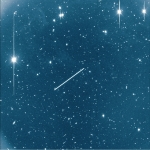
|
NEO Asteroid 2007 TU24 Flyby This false color image of NEO asteroid 2007 TU24 was obtained during the NEO closest approach on 2008 Jan. 29 (21h26-21h31UT) with 60-cm, f/3.3 Cichocki telescope, R filter and CCD. Exposure time was 5 minutes. The object brightness was about magnitude 10 and moved accross the northern sky at about 2 degrees per hour. Image scale is 2.49 arc sec/pixel. Copyright © 2008 by J. Skvarc and H. Mikuz, Crni Vrh Observatory. Flyby ephemeris for 106 Crni Vrh Observatory. |
| Detection of optical counterpart of GRB071112C at Črni Vrh Observatory (Nov. 12, 2007) | ||||
| We observed optical counterpart of Gamma Ray Burst GRB071112C (Swift trigger 296504) using 60 cm Cichocki robotic telescope at Črni Vrh Observatory. A new object was detected at RA=02:36:50.95, DEC=+28:22:16.8 (J2000). Series of nineteen connsecutive Rc filter exposures were taken, starting at 18:35:51UT, 118 seconds after the GCN notice time. We confirmed optical afterglow found by UVOT. The object was clearly detected on first nine frames after which it dropped below the detection limit. Complete results are published in GCN 7078 Circular. |
|
Relevant links:
|
| Discovery of Supernova 2007od at Crni Vrh Observatory (Nov. 2, 2007) | ||||
| On images taken by S. Maticic in the course of the Crni Vrh Asteroid and Comet Search program PIKA, an apparent bright supernova (mag 14.4) was detected using software for automatic discovery of static objects. Supernova was found on four consecutive unfiltered CCD images taken around Nov. 2.850 UT with a 0.60-m f/3.3 Cichocki Sky Survey Robotic Telescope. |
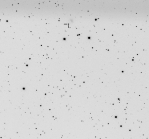
|
Discovery Image of Supernova 2007od Composite image of supernova 2007od was made by stacking four 40 second unfiltered discovery frames taken around 2007 Nov. 2.850UT with 60-cm, f/3.3 Deltagraph telescope. Image scale is 1.8 arc sec/pixel. Copyright © 2007 by S. Maticic, Crni Vrh Observatory. |
|
The new object is located at R.A. = 23h55m48s.68, Decl. = +18o24'54".8 (equinox 2000.0),
which is approximately 38" east and 31" south of the center of the nearby galaxy UGC 12846.
Nothing is visible at this location on PIKA archive images obtained
on 2004-09-11, 2005-09-30, 2006-09-01, 2006-09-20 and 2006-10-18.
Limiting magnitude on this images is 18.5 - 19.0. We checked POSS2/UKSTU Red, POSS2/UKSTU Blue, POSS2/UKSTU IR, POSS1 Red and POSS1 Blue at STSCI archives but there was no trace of any object at this position. Confirming images of 2007od, obtained with the 60-cm Cichocki reflector on Nov. 3.713 reveal magnitudes R = 13.9 and B = 14.5. Discovery was announced in CBAT Electronic Telegram No. 1116. Spectroscopic observations (CBET No. 1119), obtained on Nov. 4.11 UT with F. L. Whipple Observatory 1.5-m telescope shows it to be a type-II supernova about two weeks past the explosion. Relevant links:
|
| Discovery of Supernova 2007kg at Crni Vrh Observatory (Sept. 22, 2007) | ||||
| On images taken by H. Mikuz in the course of the Crni Vrh Asteroid and Comet Search program PIKA, an apparent supernova (mag 17.1) was detected using software for automatic discovery of static objects. Supernova was found on four consecutive unfiltered CCD images taken around Sept. 22.90 UT with a 0.60-m f/3.3 Cichocki Sky Survey Robotic Telescope. |
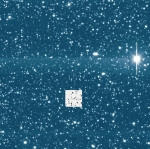
|
Discovery Image of Supernova 2007kg Composite image of supernova 2007kg was made by stacking four 25 second discovery frames taken around 2007 Sept. 22.90UT with 60-cm, f/3.3 Deltagraph telescope, operating in Scanning Along the Great Declination Circles mode. The inserted DSS image shows the area around the supernova host galaxy (barely visible on discovery image) to approximately the same scale. Image scale is about 1.5 arc sec/pixel. Copyright © 2007 by H. Mikuz, Crni Vrh Observatory. |
|
The new object is located at R.A. = 23h58m37s.43, Decl. = +60o59'06".7 (equinox 2000.0),
which is approximately 7".0 east and 6".0 north of the center of a nearby faint galaxy.
Nothing is visible at this location on several Palomar Sky Survey
images (limiting B and I magnitudes 20.0; limiting R mag 20.5) and 2MASS
images from the Aladin database. Further confirming CCD photometry with the
same telescope on Sept. 23.974 using the USNO-B1 R2 catalogue yields R =
17.17 +/- 0.04 and B = 18.62 +/- 0.10.
Discovery was announced in CBAT Electronic Telegram No. 1086. Spectroscopic observations (CBET No. 1095), obtained with F. L. Whipple Observatory 1.5-m telescope shows it to be a type-Ia supernova about three months past maximum. Relevant links:
|
| Discovery of a New Variable Star in Perseus (Sep. 16, 2007) | ||||
|
A new star-like object with coordinates ra=03:57:28.01, dec=+35:37:16.3 (J2000) was found by H. Mikuž on
unfiltered CCD images (limiting mag 19.0) in the course of the PIKA project
with the 0.60-m f/3.3 Cichocki telescope
at Črni Vrh Observatory. The object was visible on all four images of the same region taken around 2007 Sep. 16.078UT.
The magnitude was 17.9+-0.05, (using comparison stars from USNO B catalog), roughly equivalent to
R band and no motion was detected for this object. Nothing is visible at this location on our archive images
with 19.0 limiting magnitude taken on 2005-01-11, 2004-02-09 and 2003-09-26, as well as on several POSS
and 2MASS images from the Aladin database. However, the object position is consistent with USNO-B1
catalogue star 1256-0061977 with B magnitude 21.51. MPC checker returned no hits of slowly moving objects
at this location. Confirmation R and B filter photometry was obtained with 60 cm, f/3.3 Cichocki telescope, using comparison stars from USNO-B1 catalogue:
2007 Sep 16.955 R=17.65 +/- 0.05; B=17.90 +/- 0.10
Sep 17.037 R=17.39 +/- 0.04; B=17.60 +/- 0.09
The discovery was announced in IAUC 8870
|
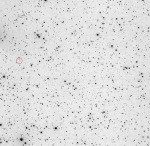
|
New Variable Star in Perseus Discovery image is a 25 second exposure obtained in Drift Scan Along the Declination Circles mode, now used in searching for new objects. The variable star was found using software for detection of new static objects. Copyright © 2007 by H. Mikuz.
|
| Perseids 2007 from La Palma (August 12, 2007) | ||||
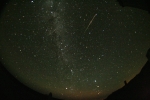
|
Perseids 2007 from La Palma Crni Vrh Observatory team member Jure Skvarc observed the 2007 Perseids next to the Jacobus Kapteyn Telescope on the Roque de los Muchachos mountain on La Palma Island. The night was perfectly clear with some wind but it did not affect observations. The images were taken on the night of Aug. 12-13, 2007 using a Canon 350D digital camera and 8 mm/f3.5 Peleng fisheye lens on static photo mount. The camera was controlled from a notebook computer. He obtained dusk to dawn long series of 30 second exposures at ISO 1600 and composed a (61 MB) AVI video animation. A 47 MB WMV video animation is also available. The image with bright Perseid shown on left is a 30 second exposure at ISO 1600, starting on Aug. 13 at 2h05m55sUT. Copyright © 2007 by J. Skvarc, Crni Vrh Observatory.
|
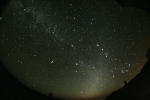
|
Perseid meteor and bright zodiacal light Another bright Perseid meteor was recorded just before dawn on Aug. 13 at 4h43m08sUT. Also there is conspicious zodiacal light extending from just rising constellation Gemini up to Taurus. Copyright © 2007 by J. Skvarc, Crni Vrh Observatory.
|
| Bright Fireball Animation (April 22, 2007) | ||||
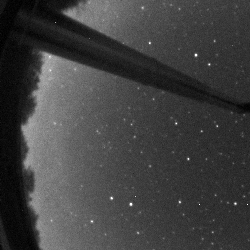
|
Bright Fireball Animation Bright fireball of about magnitude -8 was recorded over the eastern horizon with the All-Sky camera on 2007 Apr. 22 at 23h11m25s UT (center). Trace of fireball afterglow and its motion toward the south is evident on several successive exposures. The animation was prepared by Javor Kac and cover the time span of about 8 minutes. Copyright © 2007 by J. Kac and Crni Vrh Observatory.
|
| Discovery of Supernova 2007bk at Crni Vrh Observatory (Apr. 21, 2007) | ||||
| On images taken by H. Mikuz in the course of the Crni Vrh Asteroid and Comet Search program PIKA, an apparent supernova (mag 16.5) was detected using software for automatic discovery of static objects. Supernova was found on four consecutive unfiltered CCD images taken around Apr. 20.005 UT with a 0.60-m f/3.3 Cichocki Sky Survey Telescope. |
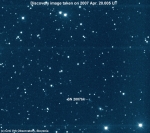
|
Image of Supernova 2007bk Composite image of supernova 2007bk was made by stacking four 25 second discovery frames taken around 2007 Apr. 20.005UT with 60-cm, f/3.3 Deltagraph telescope, operating in Scanning Along the Great Declination Circles mode. Image scale is 2.49 arc sec/pixel. Copyright © 2007 by H. Mikuz, Crni Vrh Observatory. |

|
Supernova Finder Interface Supernova 2007bk as displayed in user interface for verification of new object candidates. Copyright © 2007 by B. Dintinjana, Crni Vrh Observatory. |
|
The new object is located at R.A. = 15h28m45s.58, Decl. = +58o52'12".8 (equinox 2000.0),
which is approximately 5".0 east and 12".5 north of the center of a nearby faint galaxy.
Nothing is visible at this location on three consecutive unfiltered PIKA images obtained on
2005 Apr. 4.882 (limiting mag 18.5) or on several Palomar Sky Survey and 2MASS images from the
Aladin database. A confirming R-filtered image of 2007bk taken on Apr. 20.950 yields magnitude
R = 16.65 +/- 0.02.
Discovery was announced in CBAT Electronic Telegram No. 933. Spectroscopic observations (CBET No. 937), obtained with Heute Provence Observatory 1.93-m telescope shows it to be a type-Ia supernova around 50 days after maximum. Relevant links:
|
| Detection of optical counterpart of GRB070411 at Črni Vrh Observatory (Apr. 11, 2007) | ||||
| We observed optical counterpart of Gamma Ray Burst GRB070411 (Swift trigger 275087) using 60 cm Cichocki robotic telescope at Črni Vrh Observatory. A variable object was detected at ra=07:09:19.95, dec=+01:03:52.8. Alternating exposures using R and B photometric filters were taken. Full results are published in GCN 6270 Circular. Detailed B and R photometry, confirming the object rebrightening was performed and published in GCN 6288 Circular. |
|
Those interesting to study our original images
may download them here.
It is a 15MB tar file, including 12 individual exposures in B and R filters. In case you intend to
publish results, obtained from our images, please credit them to PIKA program at Črni Vrh Observatory, Slovenia.
Relevant links:
|
| Asteroid 2007 EH flyby (March 10-11, 2007) | ||||
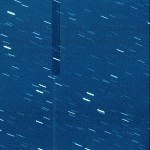
|
Asteroid 2007 EH flyby On 10-11 March 2007 a small asteroid 2007 EH flew by the Earth at a distance of only 165000 km. At a point of the closest approach it had sky motion of about 20 arc-minutes / minute. In spite of the cloudy weather we managed to make more than 300 images of this object and composed an animation showing the curved trajectory relative to the star field. The 60-cm Cichocki telescope was tracking on the object, therefore the stars appear as streaks. Exposure times were 7 second, and images were made using 2x2 binning, giving pixel size of 5 arc seconds. The animation cover a time span of 80 minutes, starting at 23h12UT on March 10. Flyby ephemeris for 106 Crni Vrh Observatory. Copyright © 2007 by J. Skvarc and H. Mikuz, Crni Vrh Observatory. High resolution movie. |
| Popolni Lunin mrk v noči 3-4 marec 2007 | |
| Posnetki popolnega Luninega mrka so bili narejeni na Astronomskem observatoriju Črni Vrh. Po začetnem oblačnem vremenu se je kako uro pred mrkom nebo zjasnilo. Šele po koncu mrka se je spet pojavilo nekaj oblakov. Sodeč po meritvah vsenebne kamere in naprave Unihedron je bilo nebo med mrkom za okoli 0,2m temnejše kot je sicer za to lokacijo običajno v nočeh brez Lune. |
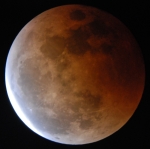
|
Total Eclipse of the Moon, March 3-4, 2007 True color image of total Moon eclipse, obtained on 2007 Mar. 3 (23h30UT) with 20-cm, f/6.3 S-C telescope and Nikon D80 camera. Camera gain set to ISO 800. Copyright © 2007 by T. Fabjan, Kobdilj Observatory. More ... |
| Discovery of NEO Asteroid 2007 DB83 at Crni Vrh Observatory (Feb. 24, 2007) |
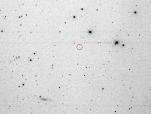
|
Click for animation of NEO asteroid 2007 DB83 discovery. Animation image was made by stacking three 25 second discovery frames taken on 2007 March 24.07 - 24.09UT with 60-cm, f/3.3 Deltagraph telescope and CCD. Image scale is 2.49 arc sec/pixel. Copyright © 2005 by S. Matičič, Črni Vrh Observatory. |
|
On images taken by S. Matičič in the course of the Črni Vrh Asteroid and Comet Search
program PIKA on February 24, 2007 an asteroid with unusual motion was automatically detected.
Confirmation images were taken on the night 26-27 February, again by S. Matičič at 106 Črni Vrh. With the semimajor axis of 1.75 AU,
inclination of 11 degrees and eccentricity of 0.30, this object belongs to the Amor asteroid family.
Estimated object diameter is about 1400 m. Closest approach to Earth will be 0.35 AU on April 15, 2007.
The orbit has been linked to observations made on 1996 Oct. 9 by 691 Steward Observatory, Kitt Peak and by
703 Catalina Sky Survey on Jan. 16 and Feb. 10, 2007.
Further observations and orbit details are in MPEC 2007-D78.
The NEO asteroid 2007 DB83 was discovered with the drift-scan along the declination circles technique that we regularly use on the 60-cm Cichocki robotic telescope. The telescope was operated remotely and the new object was automatically found by Fitsblink software. Relevant links:
|
| (89818) Jureskvarč (January 18, 2007) |
|
Asteroid (89818) was recently named in honour of our team member Jure Skvarč.
He is one of key members of Črni Vrh Observatory team, creating the
Fitsblink software
for automatic detection and astrometry of asteroids and comets. Also he give indispensable
contribution by developing electronics and software for the
60-cm Cichocki telescope as well as part of hardware and software for remote robotic
observations at Črni Vrh Observatory. The naming is important recognition to our observing
team and will stimulate further activities. It was proposed by Asiago-DLR Asteroid Survey at University of Padova. See full citation below. |
|
(89818) Jureskvarč = 2002 AX203 Discovered 2002 Jan. 2 by the Asiago-DLR Asteroid Survey at Cima Ekar. Jure Skvarč (b. 1964, Slovenia) created data analysis software for automatic astrometric measurements and asteroid search used in the scope of asteroid and comet search project at the Črni Vrh Observatory (Slovenia) and in the Astrovirtel survey at University of Padova (Italy). Naming published in MPC 58597, issued on 2007 Jan. 6. |
| Geminids Fireball Activity (December 14, 2006) |
|
We observed high activity of Geminid meteors during the nights 12. - 15. December 2006.
Several fireballs were recorded during the night of Dec. 14./15. with the Crni Vrh Observatory
All Sky Camera.
|
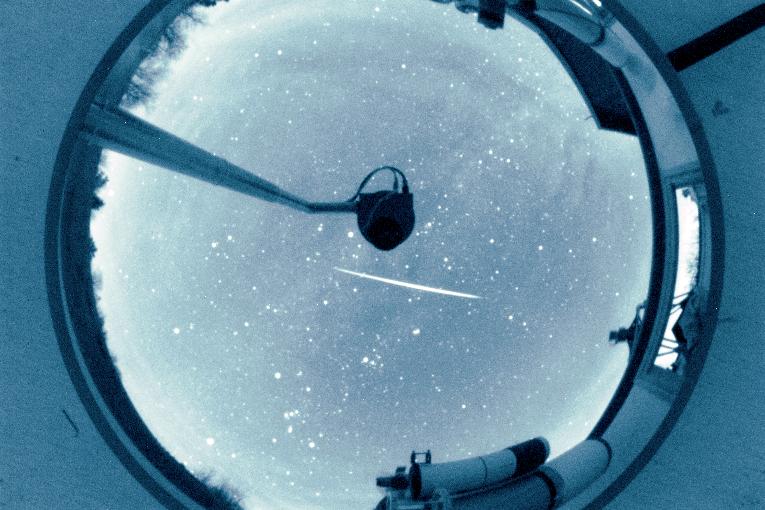
|
Geminid Fireballs High activity of Geminid meteors was recorded during the night of 13./14. and 14./15. December 2006. Several fireballs were recorded during the night of Dec. 14./15. with the Crni Vrh Observatory All Sky Camera. The 60 sec false color image of fireball was obtained on 2006 Dec. 14 at 21:52:49UT (center). Copyright © 2006 Crni Vrh Observatory. More ...
|
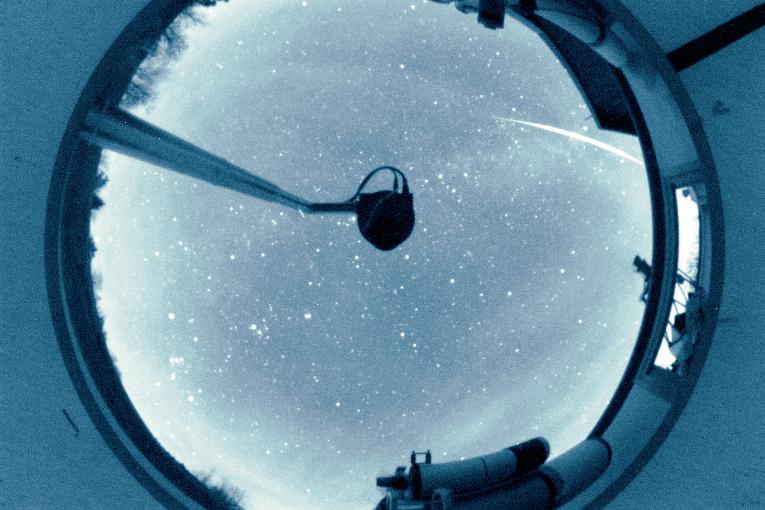
|
Geminid Fireballs The 60 sec false color image of fireball was obtained on 2006 Dec. 14 at 19:59:03UT (center). Copyright © 2006 Crni Vrh Observatory. More ...
|
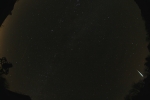
|
Geminid Fireball The 30 sec color image of a Geminid fireball was obtained on 2006 Dec. 14 at 23:06UT (start) with Canon EOS 20D DSLR camera and Peleng 3.5/8 mm fisheye lens closed to f/4. The camera gain was set to ISO 1600. Copyright © 2006 by H. Mikuz, Crni Vrh Observatory.
|
| Leonids from La Palma, Canary Islands (Nov. 19, 2006) |
| This year predicted maximum of Leonid meteors was expected for Nov. 19 at about 4h45UT. One of potentially best observing places with darkness and meteor radiant high on the sky was La Palma, Canary Islands. Unfortunately, the observations were strongly affected by clouds, so that only few meteors were recorded. |
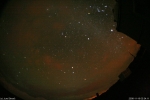
|
Leonids 2006 from La Palma Although the sky was partially obscured by clouds, a trail of bright Leonid meteor was recorded on this wide field image, obtained from 2400m elevation Roque de los Muchachos mountain on La Palma. Image was taken on 2006 Nov. 19 (starting at 03:34:11UT) with 8mm, f/3.5 Peleng fisheye lens attached to Canon 350D DSLR camera. Exposure time was 30 seconds at camera gain set to ISO 1600. See also this video animation taken from the same location on 18-19 Novemeber 2006. High activity of Leonids was predicted at about 5 UT, but nothing unusual was observed. Clouds and high humidity, causing water condensation on the camera, prevented creation of an uninterrupted animation, therefore only discontinuous patches could be joined together. Copyright © 2006 by J. Skvarč. |
| Discovery of a New Variable Star in Taurus (Oct. 26, 2006) |
|
A new star-like object (mag about 15.2) was discovered by J. Skvarč on four unfiltered CCD images
(limiting mag 18.5) taken during Oct. 26.010-26.037 UT in the course of the PIKA project
with the 0.60-m f/3.3 Cichocki telescope
at Črni Vrh. The new object is located at R.A. = 3h29m12s.26, Decl. = +12d50'17".6 (equinox 2000.0); nothing is visible at this
location on Črni Vrh archival images taken on 2004 Sept. 10, Nov. 16, and 2005 Jan. 22 (limiting mag 18.5) or on several Palomar Sky Survey
and 2MASS images from the Aladin database. Confirming unfiltered CCD images were taken with a 0.40-m f/3.6 telescope by R. Palčič at
Rezman Observatory (Slovenia) during Oct. 26.905-26.909 showing the object at
similar brightness. The discovery was announced in CBET 701
|

|
New Variable Star in Taurus Follow-up observations published in CBET 701 indicate that the object is most probably SU UMa-type cataclysmic variable. Copyright © 2006 by J. Skvarč.
|
| Detection of optical counterpart of GRB060904B at Črni Vrh Observatory (Sept. 4, 2006) |
| We observed optical counterpart of Gamma Ray Burst GRB060904B (Swift trigger 228006) using 60 cm Cichocki robotic telescope at Črni Vrh Observatory. A variable object was detected at ra=03:52:50.52, dec=-0:43:30.9. Alternating exposures using R and B photometric filters were taken. Full results are published in GCN 5511 Circular. The movie shows fast fading of this distant cosmic explosion. |
|
Those interesting to study our original images
may download them here.
It is a 15MB tar file, including 10 individual exposures. In case you intend to
publish results, obtained from our images, please credit them to Črni Vrh Observatory, Slovenia.
Relevant links:
|
| Obisk aktivnega vulkana Stromboli v času meteorskega roja Perzeidov (Avgust, 2006) |
|
Misel, da živimo na mirni in okolju prijazni Zemlji, se nam na vrhu aktivnega vulkana takoj spremeni v
zmotno. Od nastanka Zemlje, pred 4,5 milijardami let in vse do danes, naša Zemlja ni povsem ugasnila
in se ohladila. Ker njeno delovanje in s tem povezani vulkani vznemirjajo vsakega preprostega človeka,
sva se z Matejem Mihelčičem v avgustu 2006 odpravila na posebno odpravo - vzpon na vulkan Stromboli in si na
lastne oči ogledati njegove izbruhe.
Vulkan Stromboli je otok, ki se nahaja v Eolskem/Liparskem otočju v Italiji. Pred 160.000 leti je Stromboli pokukal iznad morske gladine in začel je nastajati otok, ki ima sedaj nadmorsko višino 924 metrov. Vzrok za njegov nastanek je enak kot za vse ostale vulkane (Etna in Vezuv) v Italiji - trk dveh litosferskih plošč.
|
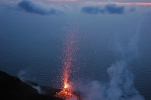
|
Stromboli Vulcano Eruptions Stromboli vulcano is located in Lipari chain of islands in Italy. Its creation started some 160.000 years ago with magma ejections that continue to occurr until today. At present, the vulcano island, is composed of lava deposits that rise some 925 meters above sea level. Outstanding video animation (20Mb) about the visit of this active vulcano was composed by Teja Fabjan. Copyright © 2006 by Teja Fabjan, Kobdilj, Slovenia.
|
|
Stromboli je zanimiv po svoji aktivnosti, ki se ponavlja na približno vsake 10 minut v obliki bruhanja
kosov magme. Vendar od časa do časa se tudi ta »urejenost« izbruhov poruši in lahko nastopi močnejši
izbruh ali celo izliv lave. Tako se je decembra 2002 zgodil izliv lave, ki je povzročil večmetrski
tsunamij, ko se je lava potopila v morje. Aprila 2003 pa je močnejši izbruh lažje poškodoval vas Ginostro
na jugozahodni strani otoka. Kljub temu lahko vsak, ki si želi videti Strombolsko aktivnost, pripleza
na vrh vulkana. To pa samo pod enim pogojem: da te po celotni poti vodi vodič, ki je za to usposobljen.
Hoja na vrh traja 2,5 uri. Na vrhu se ostane 1 uro. Vzpon se začne v poznih popoldanskih urah v vasi
San Vincenzo, tako da se izbruhe opazuje v mraku oziroma že temi, saj so takrat bolje vidni in
bolj impresivni. Spust pa traja 1,5 ure po mehki vulkanski mivki v popolni temi in z lučjo na glavi.
|
|
Vsekakor obisk Strombolija priporočava vsakomur, ki ga tovrstne stvari pritegnejo, saj v nas pusti
poseben prečat. Besedilo, slike in avtorske pravice © 2006 by
Matej Mihelčič & Teja Fabjan, Kobdilj, Slovenia.
|
| 2004 XP14 Close Flyby (July 5, 2006) |
| Total Solar Eclipse from Side, Turkey (March 29, 2006) |
|
|
| Images of total solar eclipse were obtained near Side, Turkey very close to central line with totality duration 3min 45 sec. We used a wide range of observing equipment, including 500mm, f/8 telephoto lens and Canon EOS 20D DSLR camera, Olympus DSLR with 7.2 megapixels for taking both video and still images and Sony digital video camera which we used for making video animation of the eclipse. Beside digital cameras, we observed also with two classical cameras having ordinary film for color slides (Velvia 100). The 250 mm, f/4 lens was used for making wide field images of the corona, while Peleng 8 mm fisheye lens was used for imaging the entire sky during the totality. A 12V/220V power converter was connected to our rental car and supplied 220V current for the video and Canon 20D cameras. |
| Discovery of Supernova 2006at at Crni Vrh Observatory (Mar. 9, 2006) |
| On images taken by B. Dintinjana and H. Mikuz in the course of the Crni Vrh Asteroid and Comet Search program PIKA, an apparent supernova (mag 17.1) was detected using software for automatic discovery of static objects. Supernova was found on four consecutive unfiltered CCD images taken around Mar. 8.055 UT with a 0.60-m f/3.3 Cichocki Sky Survey Telescope. |
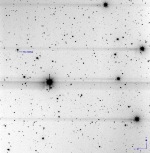
|
Image of Supernova 2006at Composite image of supernova 2006at was made by stacking four 25 second discovery frames taken around 2006 Mar. 8.055UT with 60-cm, f/3.3 Deltagraph telescope, operating in Scanning Along the Great Declination Circles mode. Image scale is 2.49 arc sec/pixel. Copyright © 2006 by B. Dintinjana and H. Mikuz, Crni Vrh Observatory. |

|
Supernova Finder Interface Image of user interface for verification of new object candidates. Copyright © 2006 by B. Dintinjana, Crni Vrh Observatory. |
|
The new object is located at R.A. = 13h12m41s.11, Decl. = +63o16'45".4 (equinox 2000.0),
which is approximately 8".0 east and 10".5 north of the center of a nearby very faint galaxy.
Nothing is visible at this location on three consecutive PIKA R-band images obtained on Feb.
12.074 (limiting mag 18.5) or on a Digital Sky Survey (DSS) image from
1993 Mar. 19 (limiting blue mag stated as 19.6).
Discovery was announced in CBAT Electronic Telegram No. 424 and confirmed by H. Yamaoka, Kyushu University; and H. Naito and N. Tokimasa, Nishi-Harima Astronomical Observatory. They obtained a low-resolution spectrum, indicating that it may be a very young supernova. Relevant links:
|
|
|
